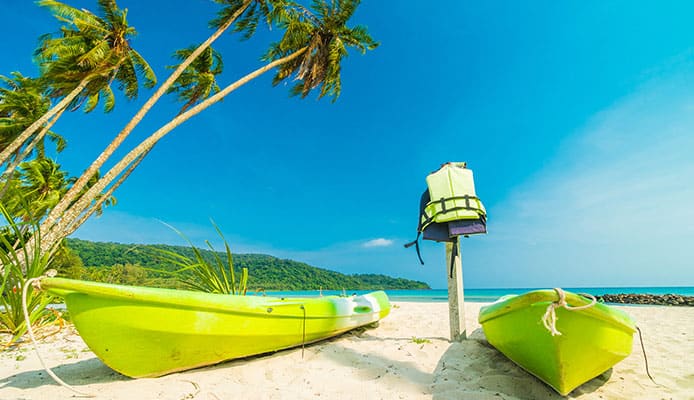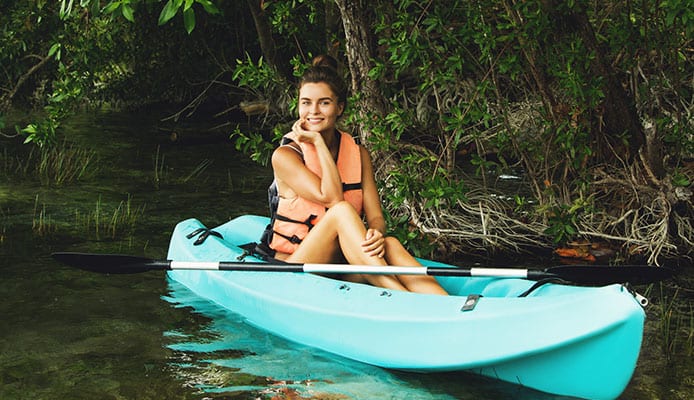How To Repair Rotomolded Polyethylene
How To Choose A Lightweight Kayak – Buying Guide

There are several things you need to think about when shopping for a new kayak. The most important thing is that you're comfortable using it – meaning you have enough space when you sit inside, you can easily take it to the location where you want to go, and you don't trip on it at home. Of course, this small and light design has a few downsides too. We made a little comparison to share with you the upsides (and downsides) of getting a lightweight kayak.
Length (Short Kayak and Long Kayaks)
The biggest upside of a shorter kayak is portability. Kayaks we reviewed are between 8 and 10 feet long, meaning they can fit in most cars. Also, it's useful if you can put your kayak somewhere out of the way when you are home.
When it comes to differences compared to long kayaks, short ones are better to use in lakes and rivers. They offer solid maneuverability but lack speed. On the other hand, long kayaks are often made to be used in the ocean for longer paddling sessions. They are often narrower and allow you to go at higher speeds.
Short kayaks have worse tracking because of their design. You often have to put in more effort to keep it in a straight line compared to long kayaks. However, if you want a versatile kayak to enjoy from time to time and to be able to take anywhere with you – a short kayak is your way to go.
Weight (Lightweight Kayak and Heavy Kayaks)
Kayak weight is one of the most important things to consider when making your decision. Like we mentioned, the biggest benefit of getting a lightweight kayak is that you can carry it on your own.
You don't need additional equipment to move them. This is very important for people who like to go paddling on their own. However, lightweight kayaks are easier to tip over, especially if waves are too high.
On the other hand, if you choose to buy a heavy kayak it will be more stable in water, and able to withstand bigger waves. However, if it does tip over you are going to have a tougher time turning it back.
If you plan on going kayaking with a partner, then you can consider buying this type of kayak. And if your kayak is too heavy, you can easily put it on a set of wheels to move it from one place to another.
Beam Width
Kayak beam width greatly determines how it's going to behave in water. If the beam of your kayak is wide, it will increase the overall stability. However, it will make the kayak more difficult to maneuver and you will spend more energy paddling because it's going to create drag.
A narrow beam allows the vessel to go at a much higher speed because there is no resistance. The maneuverability is also improved, and the vessel is more responsive. However, kayaks with narrow beams can flip over more easily because they are less stable.
Most of the kayaks we featured here are somewhere in the middle, they are good for beginners and recreational kayakers to get most out of their time on the water. Kayaks with wider beams (over 30 inches) give great stability – appreciated among anglers and photographers. This is because they don't need to paddle around too much, but need to stand up on their kayak from time to time. On the other hand, narrower kayaks create the best movement through the water without any drag, so they are very popular for kayak racing.
Inflatable Kayaks
If you want to save space and remain mobile, buying an inflatable kayak is your way to go. It comes in a bag or a backpack which is compact and easily stored, and you can take it with you wherever you go. Most come with a pump and you get a fully functioning kayak in minutes.
However, the main concern is the material they are made from. Nowadays most are made from special plastics in several layers to make it puncture-proof, but that can still happen.
They usually have separate air chambers inside so if one gets punctured the others will remain inflated and you won't be in danger. When you buy an inflatable kayak, it has to be rigid when inflated. Always fully inflate it so you get the best possible stability on the water.
Be aware that temperature can influence the air inside, so it can seem like it's deflated when it's cold, and overinflated when there's too much sun. It's not a bad idea to have the pump with you at all times.
Some kayaks have a frame inside for additional sturdiness. This type of small kayaks for adults is among the lightest you can buy, some weighing even under 20 lbs. Besides this, they are usually considerably cheaper than the hard shell options.
Other Features
Besides the main things we already pointed out, a few more can be useful. Just because the kayak is longer doesn't mean you're going to be more comfortable in it. Several small kayaks have bigger cockpits compared to some larger models. This is worth looking into if you're a tall person because you'll be spending a certain period in your vessel.
Also, it helps if the back and footrests are adjustable. Besides comfort, this allows you to have better control. Some kayaks have compartments where you can store things you take with you, and it's even better if they are waterproof. Finally, the material used can also determine the durability and performance of the kayak.
FAQs

Q: What is polyethylene?
A: This is a type of plastic that is commonly used in making kayaks. It's inexpensive, but also the heaviest material used. It's pretty tough and sturdy and can take a fair share of beating. However, the plastic is sensitive to UV rays, meaning it will start to degrade if it's exposed to the sun constantly. That's why it's a good idea to keep your polyethylene kayak covered. Even though it's sturdy, if it gets punctured by any chance it can be pretty complicated to repair. A kayak made from this type of plastic is called a rotomolded kayak and it's made into one piece. Manufacturers pour polyethylene powder into a mold which is then heated and rotated until you get the final product.
Q: What is ABS plastic?
A: The ABS plastic is a thermoplastic polymer with added styrene. It is a little lighter compared to polyethylene, but it has almost the same durability. Of course, it costs a bit more too, but nothing too serious. ABS plastic comes in sheets from which kayaks are made. The plastic sheet is heated and then pulled over a mold. This is why these kayaks are called thermoforms. The deck and hull of the kayak are made separately, and the two parts are later joined together. This is why you have two-colored kayaks many people like. Also, this plastic is much more resistant to UV rays, making this type of kayak last longer. Finally, it's eco-friendlier, because thermoform boats are easy to recycle.
Q: What are composite materials?
A: Composite materials are synthetic materials used in kayaks with the intent of improving performance and weight. Commonly used are fiberglass and carbon fibers. Composite kayaks are the fastest, most responsive, and lightest kayak made today. But this comes at a significantly higher price. The production process is somewhat similar to thermoform kayaks. Layers of composite materials are put on one another, heated, and then pulled down onto a mold. The deck and hull are made separately and joined together afterward. They are pretty tough and durable, but a sharp hit by a rock, for example, can damage the hull. Luckily, they are not that difficult to repair. Also, you don't have to worry about damage from UV rays.
How To Repair Rotomolded Polyethylene
Source: https://www.globosurfer.com/best-lightweight-kayaks/
Posted by: metzgersprevelink.blogspot.com

0 Response to "How To Repair Rotomolded Polyethylene"
Post a Comment